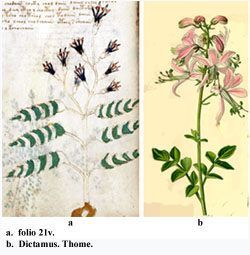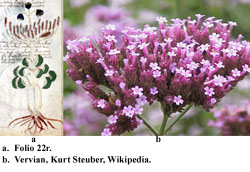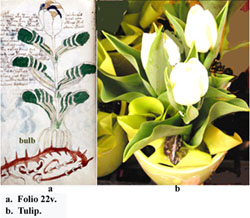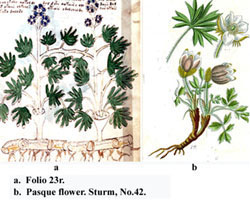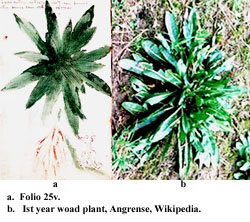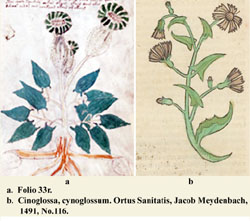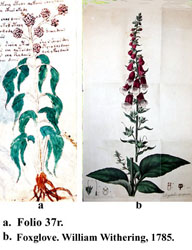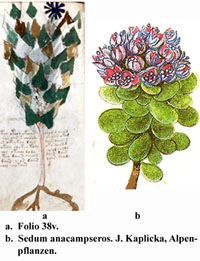The Voynich Botanical Plants
Folio 19v. Nailwort (Draba nivalis), is a tiny European plant that grows in early spring. The leaves are clustered in whorls around the plant base and the 1-2 inch long stem ends in white flowers with deeply notched petals. The plant may have been used medicinally for inflammations of the fingernails. (C)
Folio 21v. Burning bush, False Dittany (Dictamnus albus), is a native of southern Europe. During the summer, the whole plant is covered with a gluey volatile substance, which may cause the plant, in very hot weather, to ignite spontaneously. Hence the name burning bush. The plant is inedible and the leaves taste very bitter. The root was once used as a remedy for epilepsy and diseases of the head, to help resist poison and for cases of hysteria. (1) (C)
Folio 22r. Common Vervain or Holy Herb (Verbena officinalis), unlike most verbenas, is a perennial herb, native to Europe. The name holy herb may be due to the legend that it was found on the Mount of Calvary, where it was used to staunch the wounds of the crucified Savior. Medieval herbalists considered that “it was good for the stomach, liver and lungs and was applied to bites from venomous animals. It was also considered to have magical properties: “If one goes to battle, let him seek the vervian and keep it in his clothing and he will escape from his enemies.” (2) (C)
Folio 22v. Tulips, are native to southern Europe, North Africa, and Asia. They are indigenous to mountainous areas with temperate climates and need a period of cool dormancy. They thrive in climates with long cool springs and dry summers. The variegated tulip, like the one shown in the VM folio, is the result of a viral infection. The virus weakens the plants so variegated tulips have been nearly eradicated. (C)
Folio 23r. Pasque flower (Pulsatilla vulgaris), is found in short clumps in the meadows of Eurasia that have cold winters and mild summers. It is one of the first flowers to bloom in the spring, hence the name Pasque meaning Easter (Passover). As a member of the Ranunculaceae family, the plant is very toxic, producing cardiogenic toxins and oxytoxins which slow the heart in humans. The flower is useful to treat eye diseases such as cataracts. (C)
Folio 25v. Woad (Isatis tinctoria). Woad has been cultivated throughout Europe since ancient times and was the only available source for blue dye until the end of the sixteenth century. In Medieval times, Tuscany Italy was one of the centers for the cultivation of woad. It was used to dye textiles. The presence of a dragon on this folio may indicate that woad could be used in treating dragon bites. (C)
Folio 33r. Gentiana verna. This is one of the most common species of gentian found in alpine regions of central and southeastern Europe. A number of superstitions are associated with this spring-flowering gention. It is considered bad luck to bring this flower into the house; the individual woluld run the risk of being struck by lightening. Folk law suggests that death would follow if the flower was picked. (1) (C)
Folio 37r. Foxglove (Digitalis purpura). The foxglove had been used for centuries, mainly as a diuretic. William Withering (1741-1799), a British physician, observed the value of a complex herbal recipe for the treatment of dropsy (cardiac edema). His investigations showed that the active ingredient was the dried leaves of the foxglove. He determined a safe dosage for this drug, which remains in use today. (Notes from the John Martin Rare Book Room, University of Iowa) (C)
Folio 38v. Stonecrops (Sedum anacampseros). This is an alpine species of stonecrop. Its succulent leaf is occasionally used as a salad leaf or herb in Europe. The ancient Greeks used it to treat epilepsy, skin diseases and to induce abortions. (1) (C)
Folio 39v. Ragwort (Senecio vulgaris). The debate on how to control this noxious, unpleasant-smelling weed goes back as far as the 1st century. It contains many different alkaloids making it poisonous to animals and humans alike. (C)

